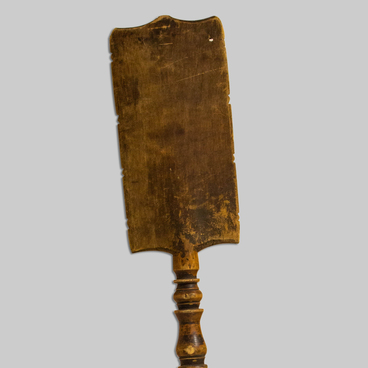In the Urals Hall, you can see a title page replica of the story The Violinist by the writer and essayist FyOdor ReshEtnikov, written in the town of Perm. This work is associated with his trip to YekaterinbUrg, where he studied the mining industry conditions in the Urals. Reshetnikov began working on the story after the publication of the manifesto on the liberation of peasants dated February 19, 1861.
In 1862, the writer submitted the story to Fyodor Dostoevsky’s magazine Vremya (literally: Time), but to no avail. The story was not published until 1932.
Drawing on the example of the PetrOvsky factory, Reshetnikov shows the life of mineworkers in the Urals after the abolition of serfdom. The writer captures the destruction of the old way of life, which is particularly obvious in the description of houses: most of them are “black, ” “dilapidated, ” sometimes to the point that “many of them were leaning towards other houses due to decay”; he directs the reader’s attention to the division between the rich and the poor at the factory, where ‘the supervisor… is as good as the master’; he shows the illiteracy and prejudices of the factory people, who thought GrIshka the Violinist was a sorcerer because ’…he knew could imitate the voice of a magpie, crow, nightingale, horse, cow, cat, and dog’.
Researcher Ivan Skvortsov interprets this text as follows: ‘The plot of the story is based on the romantic love of Grishka the Violinist, Vasily Yermolaevich Moroshin and Miron Perevalov for Anna Syulina, the daughter of a former forester. Miron Perevalov kills Grishka out of jealousy, and then dies himself. Anna Syulina marries Moroshin a year after Grishka’s death. Her life in marriage was unhappy because she 'was long unable to forget Miron and the Violinist’. The story ends with Anna dying, and Moroshin doing the same soon after. It is characteristic of Reshetnikov’s mining-themed works to include a love story in the plot, but such stories have no happy ending, and The Violinist is a case in point.
Reshetnikov attached great importance to this story and the drama Dissenter written after it. His diary contains the following entry: ‘I cannot recognize the talent in myself, let the people decide on it. I only know, or, at least, so it seems to me that The Violinist and the drama Dissenter are written to the point’.
In 1862, the writer submitted the story to Fyodor Dostoevsky’s magazine Vremya (literally: Time), but to no avail. The story was not published until 1932.
Drawing on the example of the PetrOvsky factory, Reshetnikov shows the life of mineworkers in the Urals after the abolition of serfdom. The writer captures the destruction of the old way of life, which is particularly obvious in the description of houses: most of them are “black, ” “dilapidated, ” sometimes to the point that “many of them were leaning towards other houses due to decay”; he directs the reader’s attention to the division between the rich and the poor at the factory, where ‘the supervisor… is as good as the master’; he shows the illiteracy and prejudices of the factory people, who thought GrIshka the Violinist was a sorcerer because ’…he knew could imitate the voice of a magpie, crow, nightingale, horse, cow, cat, and dog’.
Researcher Ivan Skvortsov interprets this text as follows: ‘The plot of the story is based on the romantic love of Grishka the Violinist, Vasily Yermolaevich Moroshin and Miron Perevalov for Anna Syulina, the daughter of a former forester. Miron Perevalov kills Grishka out of jealousy, and then dies himself. Anna Syulina marries Moroshin a year after Grishka’s death. Her life in marriage was unhappy because she 'was long unable to forget Miron and the Violinist’. The story ends with Anna dying, and Moroshin doing the same soon after. It is characteristic of Reshetnikov’s mining-themed works to include a love story in the plot, but such stories have no happy ending, and The Violinist is a case in point.
Reshetnikov attached great importance to this story and the drama Dissenter written after it. His diary contains the following entry: ‘I cannot recognize the talent in myself, let the people decide on it. I only know, or, at least, so it seems to me that The Violinist and the drama Dissenter are written to the point’.



